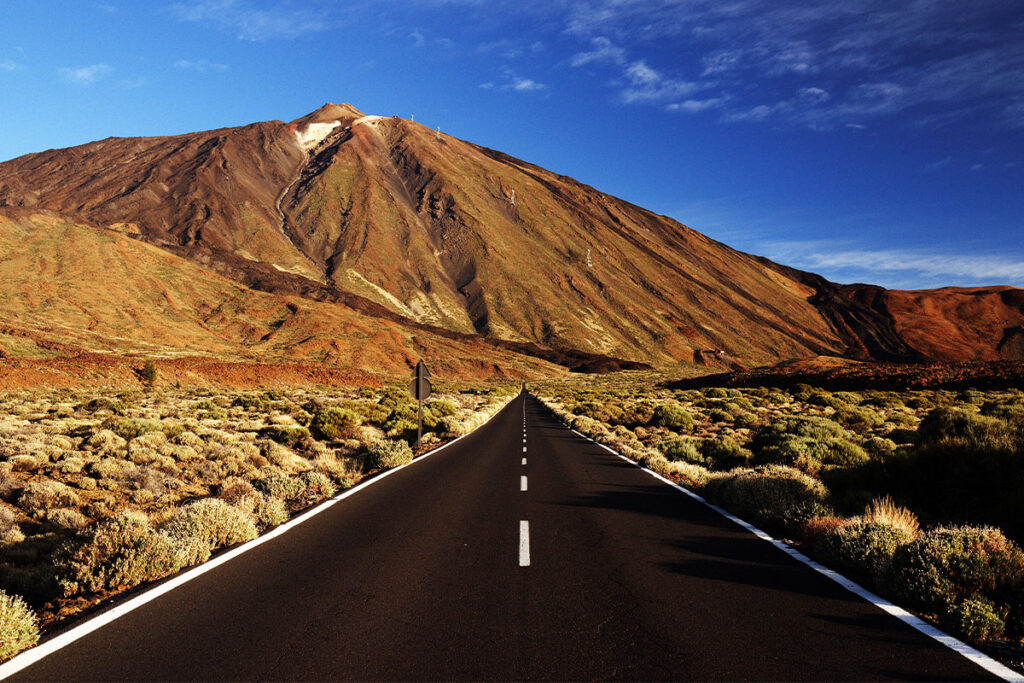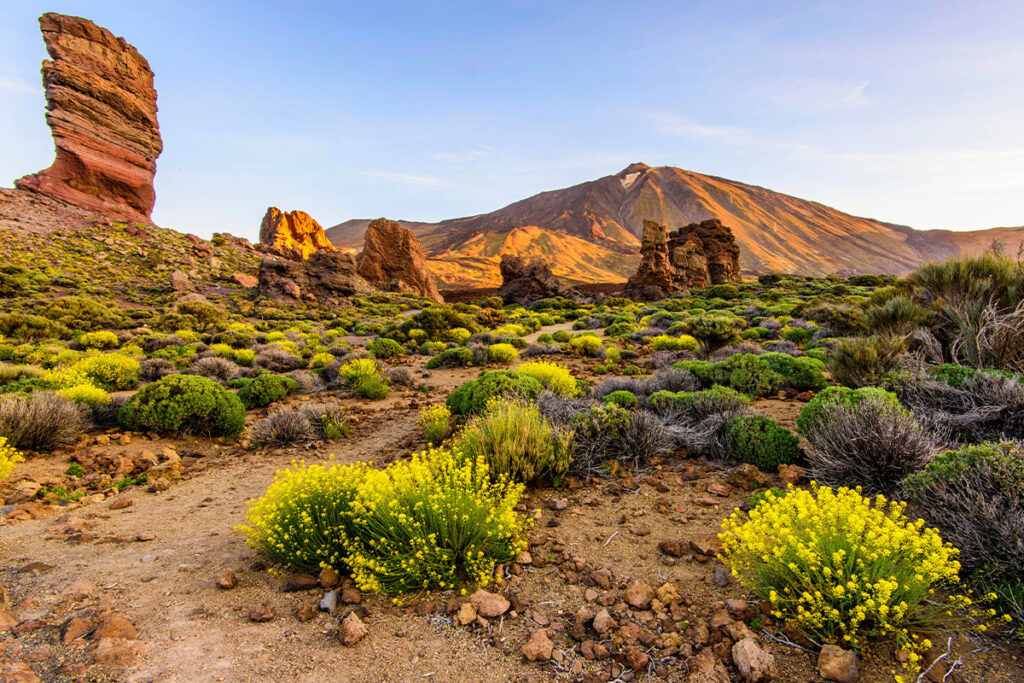Want to climb Mount Teide, but don’t know how to do it? This article will answer all your burning questions and help you learn how to prepare for trekking!
Volcano Teide (Spanish Pico del Teide) is located in Tenerife in the Canary Islands archipelago. It is the highest peak in Spain – its height is 3718 meters above sea level. Although it is an active stratovolcano, its last eruption took place in 1909. So much for the theory.
Now it’s time for a handful of practical information on how you can climb Mount Teide, what you should wear for the trip to Mount Teide, what you should remember about and why you should buy tickets for the Teleférico del Teide in advance!
Climbing Teide
The Teleférico del Teide cable car is the most popular way to climb Mount Teide. It will take you to an altitude of 3,555 m above sea level, from where you will be hiking on one of the selected routes. Find out below how it works in practice.
Teleférico del Teide valley station
The base station of the Teleférico del Teide cable car is 2,356 meters above sea level. Due to the fact that it is connected to the access roads, you can reach it from the south as well as from the north of the island. The easiest way is to rent a car (you will find free parking on site). However, if this is not possible, you can use the city bus or join an organized group tour to Mount Teide.
After reaching the base station, it’s time to queue, as almost always there are loads of people willing to climb Mount Teide. To avoid waiting at the ticket office, buy a ticket online in advance. This is the best way to save a lot of time and focus on beautiful views and unforgettable experiences. There is also a cafe, restaurant and shop on site. Here you will also get detailed information on the various hiking routes that can be followed once you reach the top station of the cable car.
Top station of the Teleférico del Teide cable car
The ride from the base station to the top station of the cable car takes about 10 minutes. This unusual trip by cable car at an altitude of several thousand meters is a unique opportunity to enjoy the wonderful views of the Teide National Park. You can admire the most beautiful ones in the morning, when the first rays of the sun are shining on the horizon.
The top station (La Rambleta) is located 3555 meters above sea level. This large difference in height has a significant effect on the temperature. If you don’t want to get cold, take warmer clothes with you. Unlike at the base station of the cable car, you won’t find any food courts here anymore. In fact, this is a place that aims to direct you to one of the three available routes, described below.
Tourist routes
You can choose one of 3 viewpoints to which 3 different hiking trails lead. Each of them has a different level of difficulty, and the walking part takes a different amount of time. What they all have in common, however, are phenomenal views which they offer and which cannot be found anywhere else in the world.
Trail No. 10 to the top of the Teide volcano (Telesforo Bravo) – this is a dream come true of almost every tourist. Climbing the top of the crater and at the same time the highest peak in Spain is an unforgettable experience. In practice, it is unfortunately not that simple. To walk along trail no. 10 you need a special permit, which is only issued by the Teide National Park authorities. You can get them by filling out a special form on this page. It is best to do this well in advance as the number of permits is very limited (200 per day) and they are usually booked several months in advance.

Trail No.11 – This route will take you to the Mirador de la Fortaleza viewpoint. Trekking in this place is not the most difficult challenge. Along the way, you will enjoy amazing views of the Teide volcanic cone and the slopes of Montaña Blanca. The Mirador de la Fortaleza viewpoint itself is a beautiful part of the La Orotava valley and the La Esperanza mountains. The white domes of the Astrophysical Observatory, located in the Teide National Park, are also a characteristic part of the landscape.
Trail No. 12 – Following this route, you will reach the Mirador Pico Viejo viewpoint. Although this trail is almost twice as long as trail No. 11, its difficulty level is comparable, or even a bit easier. In terms of views, the most interesting are the various volcanic formations that remind us of where we are. Pico Viejo (aka Montaña Chachorra) crater with a diameter of 800 meters, Mount Montaña Guajara, steep rocks of Los Roques de García and the Los Gemelos Mountains are just some of the views you will enjoy on this tour. if the weather is good, you will also see the nearby islands of La Gomera, La Palma and El Hierro.
Practical advices
Are you wondering if you already know everything about how to climb the Teide volcano? Below you will find the most important information that you need to keep in mind:
- Teleférico del Teide runs from 9:00 am to 4:00 pm from the base station. In the event of strong wind or difficult weather conditions, its operation may be halted. This, however, doesn’t happen very often. One-way cable car ride takes approximately 10 minutes.
- If you are planning to climb the Teide peak (trail no. 10), be sure to obtain a permit a few months in advance. You can apply for a permit by completing the form on this page.
- There is one more way to reach the Pico del Teide peak without a permit. An alternative, legal way to reach the peak without a permit is to stay overnight at the Altavista Refuge on Teide and start the climb the following day before 9:00 am (address: Altavista Refuge, TF-21, KM 40, 2, 38300 La Orotava).
- It is not recommended for pregnant women, young children, and people with heart disease to go up the mountain. Symptoms such as nausea, dizziness or a fast heartbeat may occur. It is mainly due to changes in altitude, pressure changes and thinned air.
- Bring warm clothes with you. While in the south of the island you can sunbathe and take a dip in the ocean, there can still be snow at the top of Teide! Comfortable shoes, sunglasses and sunscreen will also be useful.
- Remember to climb slowly, because high altitude and sulfur floating in the air can be problematic even to people with experience in climbing.
- Volcano Teide is located in the Teide National Park and is a protected area. Respect it, take care of cleanliness and your own and other people’s comfort.
Teide National Park

The most famous volcano in Tenerife is not the only attraction that awaits you in this part of the island. Equally interesting is the Teide National Park that surrounds it (one of several national parks in Spain). Its uniqueness can be proved by the very fact that it has been inscribed on the UNESCO World Heritage List. Teide National Park is rich in flora and fauna, as well as an ideal place for star gazing. While in the park we can visit the Teide observatory, as well as a museum presenting the history of the volcano and Tenerife.
GOOD TO KNOW: There are two tourist centers in the Teide National Park, one in El Portillo and one at the Parador Nacional Hotel.
Practical info
It is best to buy tickets for the cable car, guided tours and the Astrophysical Observatory online in advance. You will then avoid standing in a long queue and avoid the risk that all tickets have been sold out.
